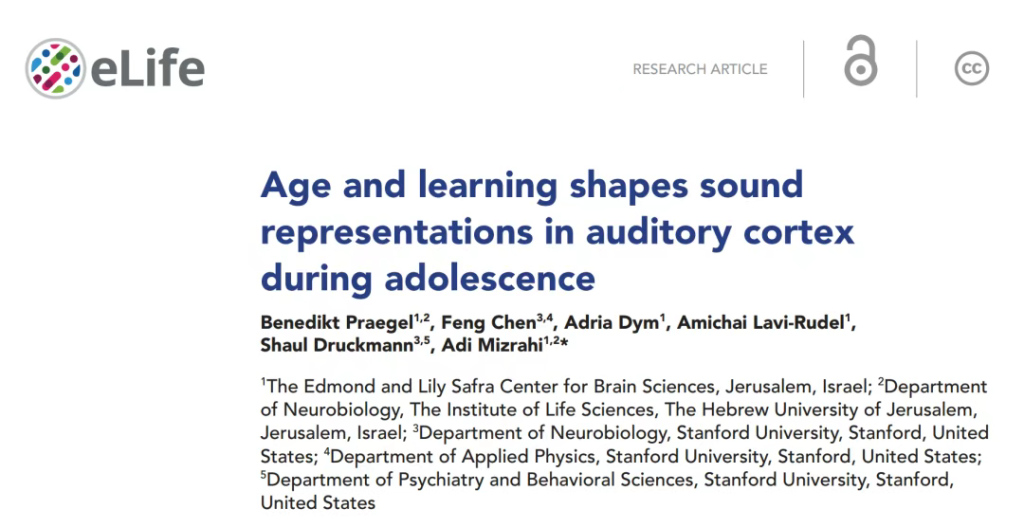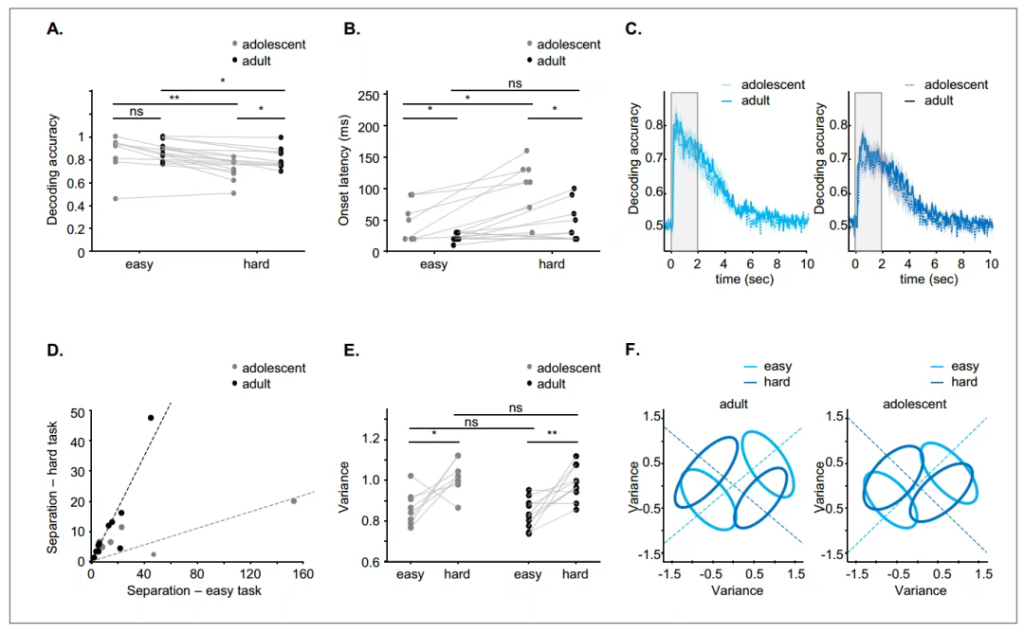Adolescence is a period of significant biological change, and mice are no exception. While the adolescent mouse brain exhibits high plasticity, the specific developmental patterns of auditory perception and cognitive abilities have remained incompletely understood. Do adolescent and adult mice perform differently in sound discrimination tasks? What distinguishes their underlying neural activity patterns?

On October 13, 2025, Benedikt Praegel and his team at the Hebrew University of Jerusalem published a study titled “Age and learning shapes sound representations in auditory cortex during adolescence” in eLife. The research compared adolescent (postnatal days 20–42) and adult (postnatal days 60–82) mice using pure-tone discrimination tasks of varying difficulty. Mice were trained to respond by licking to different tone frequencies for rewards, with incorrect responses lightly penalized. High-density electrophysiological recordings monitored auditory cortex spiking activity at single-neuron resolution during task performance. The study reveals unique neurophysiological and behavioral characteristics in adolescent mice, highlighting ongoing development of cognitive control and cortical plasticity during this sensitive period.

Adults Excel in Difficult Auditory Tasks
Fifteen adolescent and 15 adult mice underwent three days of tone-reward association training, followed by one week each of easy and then easy + difficult task training. While both groups learned the easy task at comparable rates, introducing the difficult task caused adolescent performance to decline significantly, whereas adults maintained stable performance. Adults also showed better discrimination ability (d’) in the difficult task and improved in the second week, while adolescents did not. Age was identified as the primary factor in difficult task performance differences.

Adolescents Show Higher Licking Bias and Behavioral Variability
Psychometric curve and sigmoid fitting revealed similar perceptual sensitivity between groups, but adolescents had higher false alarm rates. Lower C-bias values indicated weaker lick suppression ability in adolescents. Throughout training, adolescents exhibited higher maximum licking bias, which increased further during difficult tasks. They also showed greater behavioral variability and shorter inter-trial intervals after false alarms, reflecting higher impulsivity and immature cognitive control.

Superior Performance Persists in Head-Fixed Paradigm; Auditory Cortex is Task-Critical
In head-fixed training with water restriction, adolescent mice completed fewer trials per session but reached easy-task proficiency at a similar rate. Consistent with free-moving results, adolescents showed performance decline in difficult tasks and greater licking bias. Optogenetic inhibition of ACx excitatory neurons significantly impaired both easy and difficult task performance, confirming the necessity of auditory cortex for task execution.

Immature Stimulus and Choice Representations in Adolescent ACx
Neuropixels-1 probe recordings of ACx neurons (AUDd, AUDp, AUDv, TEa) focused on layer 5/6 excitatory tone-responsive neurons. ROC analysis showed that while most neurons in both groups could discriminate stimuli and choices, adolescent neurons had longer discrimination latency, lower maximum AUC, and shorter duration of selective activity. These trends were consistent across ACx subregions, indicating overall functional immaturity.

Adult ACx Populations Enable Better Decoding of Difficult Tasks
Linear discriminant analysis (LDA) of Hit vs. Correct Rejection trials showed comparable decoding accuracy in easy tasks, but adults performed significantly better in difficult tasks. Adults also had shorter decoding latencies across tasks. Fisher separability was higher in adults, indicating more efficient population coding.

Age and Learning Jointly Shape ACx Plasticity
Comparisons between novice and expert groups revealed significant main effects of age, learning, and task difficulty on neuronal discriminability (AUC). Adults and experts showed higher maximum AUC, with significant age × learning and learning × difficulty interactions. In easy tasks, neuronal AUC correlated with behavioral d′ in both groups, but only adults showed this correlation in difficult tasks, linking adolescent behavioral deficits to immature neural representations.

Adult-Specific Learning-Induced Tuning Plasticity in Passive Listening
In passive listening experiments, expert adult mice exhibited narrowed frequency tuning bandwidth, reduced population sparseness, and increased neuronal d′, while adolescent experts showed no significant learning-induced changes. Subregional analysis indicated limited plasticity in adolescent AUDp and no changes in AUDv, whereas adults showed broader ACx plasticity, suggesting regional constraints and overall weaker learning-induced plasticity in adolescence.

Conclusion
Adolescence is characterized by high plasticity, yet how ongoing development affects sensory processing and cognitive function remains unclear. This study demonstrates that adolescent mice perform worse than adults in difficult auditory discrimination tasks, due to higher response variability and weaker cognitive control, particularly elevated licking bias. While pure tone representations were similar outside behavioral contexts, learning under task conditions revealed significant differences in cortical representations between ages. Adolescents showed immature stimulus and choice representations at the single-neuron level, poorer population decoding of difficult tasks, and slower cortical decoding. Notably, age-related differences were amplified after learning, highlighting the combined impact of age and experience. These findings reveal unique neurobehavioral characteristics in adolescent mice and emphasize the ongoing maturation of cognitive control and cortical plasticity during this developmental window.
Full Citation:
Praegel, B., et al. (2025). Age and learning shapes sound representations in auditory cortex during adolescence. eLife, 14:e106387.
DOI: https://doi.org/10.7554/eLife.106387.4
